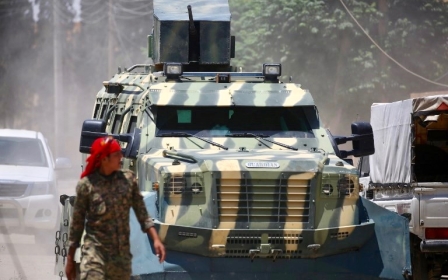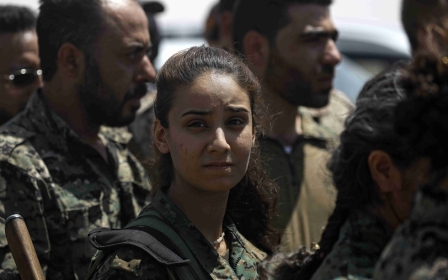UN: 300 dead in 'staggering' civilian toll from US-led air strikes in Raqqa

United Nations war crimes investigators said on Wednesday that intensified US-led coalition air strikes on Islamic State's stronghold of Raqqa in Syria are causing a "staggering loss of civilian life".
US-led coalition warplanes are supporting an alliance of Kurdish and Arab fighters who are battling to take the city from Islamic State militants.
The Syrian Democratic Forces (SDF) began to attack Raqqa a week ago with the aim of taking it from the militant group. The SDF, supported by heavy coalition air strikes, have taken territory to the west, east and north of the city.
Paulo Pinheiro, chairman of the UN Commission of Inquiry, said that intensified coalition air strikes have killed at least 300 civilians in the Syrian northern city of Raqqa since March.
He also told the Human Rights Council that 10 agreements between the Syrian government and armed groups to evacuate fighters and civilians from besieged areas, including eastern Aleppo, "in some cases amount to war crimes" as civilians had "no choice".
He said: "We note in particular that the intensification of air strikes, which have paved the ground for an SDF advance in Raqqa, has resulted not only in staggering loss of civilian life, but has also led to 160,000 civilians fleeing their homes and becoming internally displaced."
Pinheiro provided no figure for civilian casualties in Raqqa, where rival forces are racing to capture ground from Islamic State. The Syrian army is also advancing on the desert area west of the city.
Responding to the reports, rights group called on the US-led coalition in Syria to prioritise protecting civilians in the offensive to retake Raqqa from the Islamic State group on Wednesday.
“The battle for Raqqa is not just about defeating ISIS, but also about protecting and assisting the civilians who have suffered under ISIS rule for three and a half years,” Lama Fakih, deputy Middle East director at Human Rights Watch (HRW) said in a statement on Wednesday.
“Coalition members and local forces should demonstrate concretely that the lives and rights of hundreds of thousands of civilians in Raqqa are a parallel priority in the offensive,” added Fakih.
In a report published by the Combined Joint Task Force – Operation Inherent Resolve (CJTF-OIR) on 2 June, the task force said: “To date, based on information available, CJTF-OIR assesses that, it is more likely than not, at least 484 civilians have been unintentionally killed by Coalition strikes since the start of Operation Inherent Resolve.”
Meanwhile, the UK-based Syrian Observatory for Human Rights (SOHR) reported that at least 225 civilians including 44 children and 36 women had been killed in the month between 23 April and 23 May, the highest monthly toll since the US-led coalition began its campaign against IS in 2014.
HRW has also documented several missiles and aerial attacks carried out by US-led forces in Syria that caused civilian casualties since September 2014.
White phosphorous
Separately, HRW expressed concern about the use of incendiary white phosphorous weapons by the US-led coalition fighting IS in Iraq and Syria, saying it endangers civilians when used in populated areas.
"No matter how white phosphorus is used, it poses a high risk of horrific and long-lasting harm in crowded cities like Raqqa and Mosul and any other areas with concentrations of civilians," said Steve Goose, arms director at HRW.
Videos apparently recorded by IS showed white phosphorous artillery shells exploding in the air during fighting in Raqqa last week.
White phosphorous can be used in war to create illumination or smoke screens that obstruct an enemy's view of the battlefield and act as cover for allies.
However, the substance burns at extremely high temperatures, ignites other materials on contact and burns through skin. It is also extremely poisonous.
Its use as an offensive weapon is banned by the UN, but its use in screening is not.
Ryan Dillon, a US army colonel and a spokesman for the US coalition, said: "In accordance with the law of armed conflict white phosphorus rounds are used for screening, obscuring, and marking in a way that fully considers the possible incidental effects on civilians and civilian structures.
"However, IS continues its blatant disregard for innocent human life by killing civilians trying to flee the fighting and the coalition will not stand idly by and allow civilians to die needlessly if we can help protect them," he said.
HRW said it had not been able to independently verify any civilian casualties resulting from the use of white phosphorus.
Humanitarian crisis
The battle to oust the IS from its stronghold of Raqqa is also creating daunting challenges for aid groups responding to the latest humanitarian crisis in the Syrian conflict.
Tens of thousands of civilians have fled Raqqa and its surroundings since the US-backed Syrian SDF began its operation to capture the IS stronghold last year.
But new waves of displacement are expected as the battle inside the city progresses.
A key problem is getting aid supplies to the relatively remote desert region in Syria's north, with just a trickle of assistance currently crossing from neighbouring Turkey and Iraq.
"There is supply but it's very, very limited and the needs of the population are very high," said Puk Leenders, emergency coordinator for northern Syria for the group Doctors Without Borders (MSF).
Turkey considers the key Kurdish component of the SDF a "terrorist" group and its border with the area north of Raqqa is effectively closed.
The border crossing with Iraq, over 300 kilometres east of Raqqa city, is open to goods, but in practice sees little traffic, local officials say.
The United Nations, which operates inside Syria with government permission, has been able to airlift supplies to the city of Qamishli, northeast of Raqqa, from government-held Damascus.
But "this offered limited capacity and was insufficient to meet all needs", said David Swanson, regional spokesman for the UN's Office for the Coordination of Humanitarian Affairs (OCHA).
The UN is now hoping to start transporting aid from Aleppo to Qamishli, a distance of more than 400 kilometres, but the route must first be tested for security, said Swans
Middle East Eye propose une couverture et une analyse indépendantes et incomparables du Moyen-Orient, de l’Afrique du Nord et d’autres régions du monde. Pour en savoir plus sur la reprise de ce contenu et les frais qui s’appliquent, veuillez remplir ce formulaire [en anglais]. Pour en savoir plus sur MEE, cliquez ici [en anglais].





